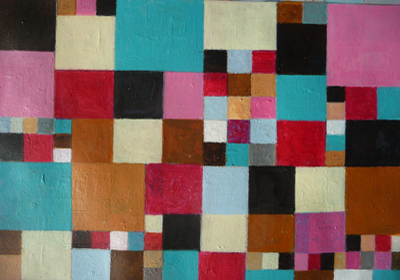 Thijs’ work constitutes a fascinating visual story, in which his intense admiration for nature is expressed in a poetically abstract manner. Colour has become autonomous, and determines the final form. Similar colours and shapes rhyme with each other in lively and musical compositions which ultimately become pure poetry. The metre of this comes from the rhythm of his experiments with paint, and this he has christened ‘Coloritme’ (colour rhythm). A characteristic of his work is the contrasting combinations of primary and complementary colours through which the flat surface achieves depth. The surface structure, built up in many layers, increases this three-dimensionality with a suggestion of erosion, as if through the ravages of time
Thijs’ work constitutes a fascinating visual story, in which his intense admiration for nature is expressed in a poetically abstract manner. Colour has become autonomous, and determines the final form. Similar colours and shapes rhyme with each other in lively and musical compositions which ultimately become pure poetry. The metre of this comes from the rhythm of his experiments with paint, and this he has christened ‘Coloritme’ (colour rhythm). A characteristic of his work is the contrasting combinations of primary and complementary colours through which the flat surface achieves depth. The surface structure, built up in many layers, increases this three-dimensionality with a suggestion of erosion, as if through the ravages of time
The landscape remains an inexhaustible source of inspiration. The depiction of this is reduced down to simple horizontal, vertical and diagonal movements, which comprise the framework for the construction of the painting. With the gradual fading of the horizon, the colour elements are so arranged that they appear to vanquish the powers of darkness and take possession of the space, of infinity, of air and light. It is an almost transcendental ecstasy. With his technical expertise and sensitive movements, this ‘builder with brush and palette knife’ manages to evoke space in an ever more magical way.
Extracts from a lecture by Professor Jojada Verrips in the Van der Togt Museum, Amstelveen, on The continuing relationship between Thijs’ works of art and architecture:
Thijs has produced works of art that form an integral part of the building works for which he has designed them: in short, integral monumental art. The golden thread of Thijs’ oeuvre seems to be: art and architecture and art as architecture; art and construction and art as construction; art and monument and art as monument, on the understanding that size is irrelevant: after all, a work need not be large to give an impression of monumentality.
Harmonious construction with colours has become an unmistakable stylistic hallmark of Thijs’ work, in the best tradition of Modern painting. This brings to mind a relevant statement by Sonia Delaunay, pioneer of Orphism, a movement in which geometric forms and strong colours play a key role:
Abstract art is a beginning of liberation from the old habits of painting. But the true new painting will begin only when it is understood that color has a life of its own, that infinite combinations of color have their poetry and a poetic language much more expressive than ancient methods.
[Amsterdam, 26 October 2007]